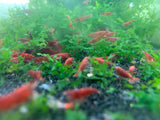
"
Bloody Mary shrimp" can refer to either a vibrant, deep red aquarium shrimp or a cocktail appetizer featuring cooked shrimp in a Bloody Mary-flavored sauce. The context of your request will determine which meaning is most relevant.
Bloody Mary aquarium shrimp
The Bloody Mary shrimp (Neocaridina davidi) is a freshwater dwarf shrimp popular in the aquarium hobby for its intense, translucent red coloration. They are bred from chocolate-colored shrimp, a lineage distinct from the more common Red Cherry shrimp, which have a red shell over a transparent body. This makes the Bloody Mary's color appear more deeply saturated, like a liquid ruby.
Care and requirements
According to sellers like SF Aquatic, these shrimp are a hardy, beginner-friendly species.
-
Water parameters: They can tolerate a relatively wide range of conditions, but a stable, mature tank is crucial for their well-being.
- Temperature: 65–80°F (18–27°C)
- pH: 7.5–8.0
- TDS: 170–250 ppm
- KH: 100–120
- Diet: Bloody Mary shrimp are active foragers that clean the tank by grazing on algae and biofilm.
- Compatibility: They are peaceful and should not be housed with fish that may eat them. To maintain their deep red color, they should be kept separate from other Neocaridina color varieties to prevent cross-breeding, which can result in duller offspring.
Characteristics
- Size: N. davidi are small, with females growing to a maximum size of 3–4 cm (1.2–1.6 inches) and males typically being slightly smaller.
- Temperament: They are peaceful scavengers that spend most of their time grazing on algae, biofilm, and decaying plant matter. In an aquarium, they help keep the tank clean.
-
Appearance: The wild-type coloration is a mottled greenish-brown. However, selective breeding has created numerous color morphs, including:
- Red: The most famous variety, often called Cherry, Sakura, or Fire Red shrimp.
- Yellow: Yellow Goldenback and Yellow Sakura shrimp.
- Blue: Blue Dream, Blue Velvet, and Blue Jelly shrimp.
- Green: Green Jade shrimp.
- Black/Brown: Black Rose and Chocolate shrimp.
- Patterned: Rili shrimp, which have translucent midsections with colored heads and tails.
- Sexual dimorphism: Females are larger and more vividly colored than males. They also develop a "saddle"—unfertilized eggs in their ovaries visible behind their head—and carry eggs, known as being "berried," under their tail.
Care and habitat
- Tank setup: Neocaridina are ideal for a species-only tank of at least 5 gallons, though a 10-gallon or larger tank offers more stability. They prefer heavily planted environments with features like driftwood, rocks, and leaf litter for grazing and hiding.
-
Water parameters: This species is tolerant of a wide range of conditions, but stability is key. They thrive in:
- Temperature: 68–78°F (20–25°C)
- pH: 6.5–8.0
- Hardness (GH): 6–8
- Ammonia/Nitrite: Always 0 ppm
- Nitrate: Below 20 ppm
- Diet: As omnivorous scavengers, their diet can be supplemented with high-quality shrimp pellets, algae wafers, blanched vegetables, and powdered foods for juveniles.
- Breeding: They are prolific and easy to breed in captivity. Females carry 20–40 eggs for 2–3 weeks, after which the young hatch as miniature versions of the adults (direct development).
- Caution: These shrimp are highly sensitive to copper, which is present in some plant fertilizers and medications. They also require a fully cycled and stable tank, as they are susceptible to rapid changes in water chemistry.
Bloody Mary plus for DOA
We Also Recommend
Customer Reviews
Based on 3 reviews
Write a review











